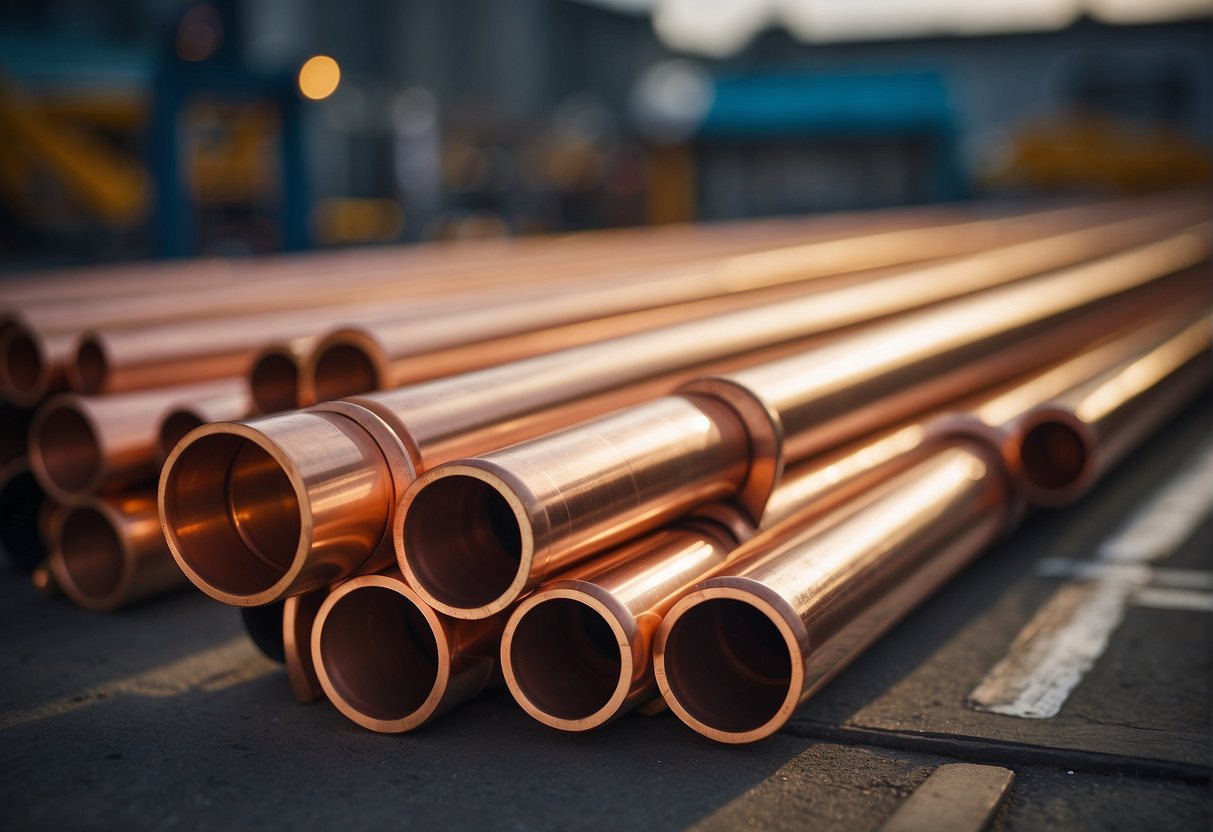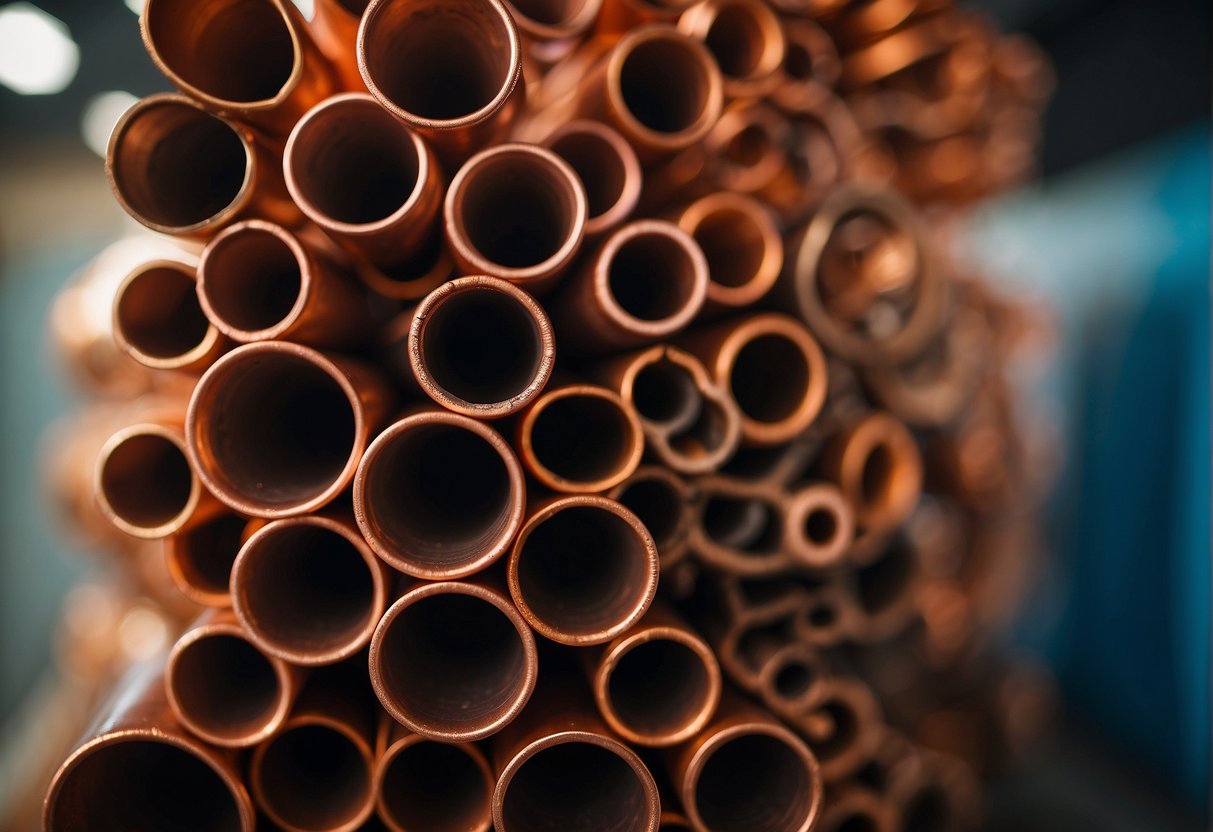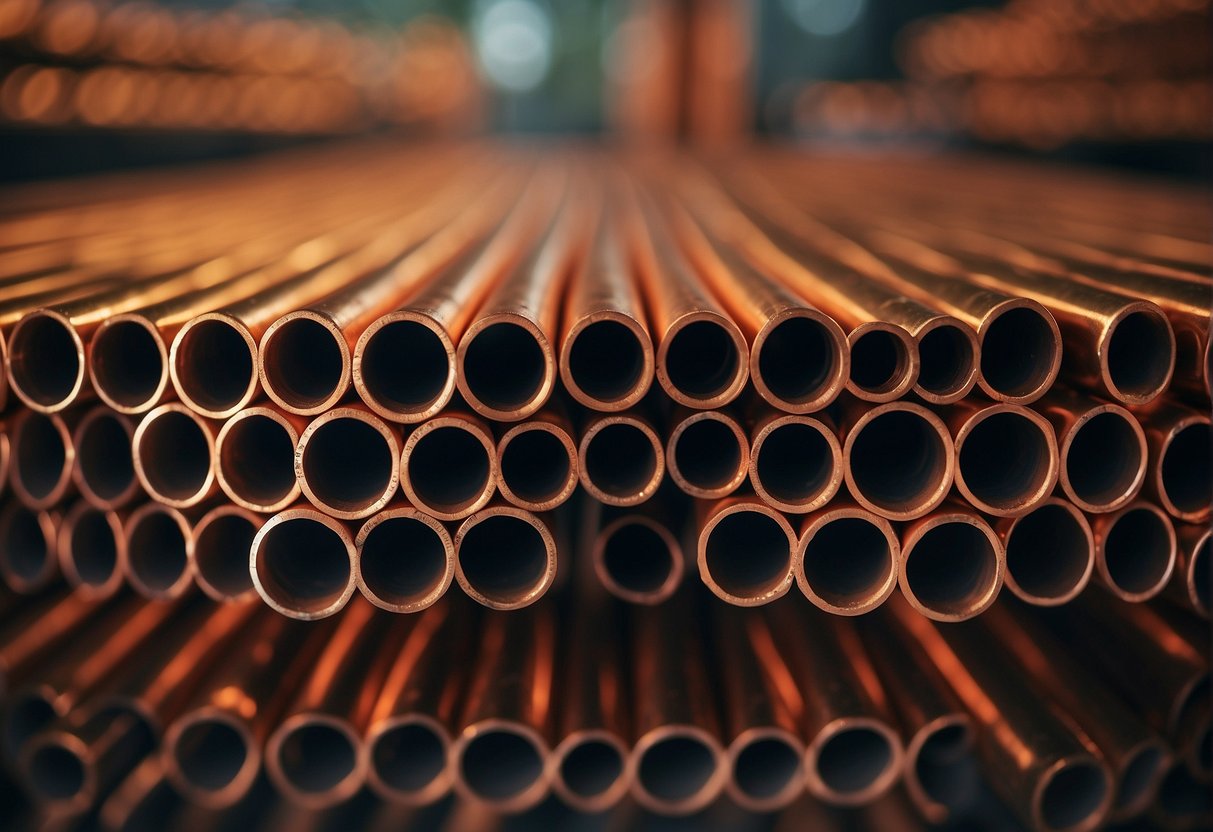Copper and PVC pipes are two of the most commonly used materials in plumbing systems. Both materials have their own unique strengths and weaknesses, making it important to weigh the pros and cons of each before deciding which one to use.
Copper pipes are known for their durability and longevity. They are resistant to corrosion and can last for up to 50 years or more with proper installation and maintenance. Additionally, copper pipes are more environmentally sustainable than other metal piping options and can handle high water temperatures, making them ideal for water supply lines. However, copper pipes can be significantly more expensive than PVC pipes and emit more noise, which can be a concern for some homeowners.
On the other hand, PVC pipes are lightweight, affordable, and easy to install. They are also resistant to chemicals and can last for up to 25 years or more with proper installation and maintenance. However, PVC pipes are not as durable as copper pipes and can become brittle over time, especially in areas with extreme temperature fluctuations. Additionally, PVC pipes are not suitable for hot water applications and can release toxic fumes when burned.
Key Takeaways
- Copper pipes are durable and long-lasting, but can be expensive and emit more noise than PVC pipes.
- PVC pipes are affordable and easy to install, but not as durable as copper pipes and can release toxic fumes when burned.
- When choosing between copper and PVC pipes, it’s important to consider factors such as cost, durability, and environmental impact.
Material Properties and Applications
Chemical and Corrosion Resistance
As a material, copper is highly resistant to corrosion and chemical reactions, making it an ideal choice for plumbing systems. Copper pipes are not affected by chlorine, which is commonly used to disinfect water. This means that copper pipes can last for decades without corroding or degrading. On the other hand, PVC pipes are not as resistant to chemicals and can be damaged by exposure to certain chemicals, such as gasoline or oil. PVC pipes can also be affected by exposure to sunlight, which can cause them to become brittle and crack.
Temperature Tolerance and Insulation
Copper pipes have excellent temperature tolerance and can withstand high temperatures without melting or deforming. This makes them ideal for use in hot water systems, such as those used for showers or washing machines. Copper pipes also have a high thermal conductivity, which means that they can transfer heat quickly and efficiently. This makes them ideal for use in heating systems. PVC pipes, on the other hand, have a lower temperature tolerance and can melt or deform if exposed to high temperatures. PVC pipes also have a lower thermal conductivity, which means that they are less efficient at transferring heat.
Durability and Longevity
Copper pipes are highly durable and can last for decades without needing to be replaced. They are also resistant to damage from impact or bending, which makes them ideal for use in areas where they may be subject to physical stress. PVC pipes, on the other hand, are less durable and can become brittle over time, especially if exposed to sunlight. PVC pipes also have a shorter lifespan than copper pipes and may need to be replaced more frequently.
In terms of applications, copper pipes are commonly used in plumbing systems for residential and commercial buildings. They are also used in heating systems and for transporting hot water. PVC pipes are commonly used in drainage systems, irrigation systems, and for transporting cold water.
Overall, both copper and PVC pipes have their advantages and disadvantages. The choice between the two will depend on the specific application and the needs of the user. It is important to consider factors such as chemical resistance, temperature tolerance, durability, and longevity when choosing between copper and PVC pipes.
Installation and Repair Considerations
When it comes to installation and repair considerations, both copper and PVC pipes have their pros and cons. As a professional plumber, I have experience working with both types of pipes, and here is what I have learned:
Ease of Installation
PVC pipes are generally easier to install than copper pipes. They are lightweight, flexible, and easy to cut, making them a popular choice among DIY enthusiasts. However, it is important to note that PVC pipes require special tools and techniques for joining, such as solvent welding, which can be tricky for beginners.
Copper pipes, on the other hand, are heavier and more rigid, making them more difficult to work with. They require soldering to join, which requires a certain level of skill and experience. However, once installed, copper pipes are less likely to leak and can withstand higher water pressure.
Repair and Maintenance
When it comes to repairs and maintenance, PVC pipes are generally easier and cheaper to fix than copper pipes. For example, if a PVC pipe is damaged, it can usually be repaired with a simple patch or replacement of the damaged section. Copper pipes, on the other hand, require more extensive repairs, such as soldering and replacement of the entire section.
It is also worth noting that copper pipes are more prone to corrosion and mineral buildup, which can affect water flow and quality. PVC pipes, on the other hand, are resistant to corrosion and do not require as much maintenance.
Plumbing System Integration
When it comes to integrating with your plumbing system, both copper and PVC pipes have their advantages. Copper pipes are more durable and can withstand higher water pressure, making them ideal for use in hot water systems. PVC pipes, on the other hand, are more flexible and can be used in a wider range of plumbing applications.
Overall, the choice between copper and PVC pipes depends on your specific needs and preferences. As a professional plumber, I recommend consulting with a licensed plumber to determine the best type of pipe for your plumbing system.
Cost Analysis
When it comes to choosing between copper and PVC pipes, cost is a major factor to consider. In this section, I will break down the initial investment and long-term expenses of both types of pipes.
Initial Investment
Copper pipes are generally more expensive than PVC pipes. According to Angi, copper pipes can cost up to $20-$30 per linear foot, while PVC pipes cost only $.50-$5 per linear foot. Additionally, the installation of copper pipes can be more labor-intensive, which can add to the overall cost of the project.
On the other hand, PVC pipes are more budget-friendly and easier to install. This makes them a great option for those who are looking to save money on their plumbing project.
Long-Term Expenses
While copper pipes may have a higher initial investment, they tend to last much longer than PVC pipes. According to Black Tie Plumbing, copper pipes can last up to 70 years, while PVC pipes have a lifespan of 25-40 years.
This means that while PVC pipes may be cheaper initially, homeowners may end up spending more money in the long run due to the need for more frequent replacements.
In conclusion, when it comes to cost analysis, both copper and PVC pipes have their pros and cons. While copper pipes may have a higher initial investment, they tend to last longer, making them a more cost-effective option in the long run. However, PVC pipes are more budget-friendly and easier to install, making them a great option for those who are looking to save money on their plumbing project.
Environmental Impact and Safety
When it comes to comparing copper and PVC pipes, one of the most important factors to consider is their environmental impact and safety. In this section, I will discuss the sustainability and recycling of both materials, as well as any health and safety concerns associated with their use.
Sustainability and Recycling
Copper is a highly sustainable material, with a recycling rate of over 90%. This means that the majority of copper pipes in use today are made from recycled materials, which helps to conserve natural resources and reduce waste. In addition, copper pipes have a lifespan of up to 50 years, which means that they do not need to be replaced as frequently as other materials.
PVC, on the other hand, is a type of plastic that is derived from non-renewable resources. While PVC pipes can be recycled, the process is more complex than recycling copper, and the resulting material is of lower quality. PVC pipes also have a shorter lifespan than copper pipes, which means that they need to be replaced more frequently.
Health and Safety Concerns
One of the main concerns with PVC pipes is the potential for chemical leaching. PVC contains a number of additives that can be released into the water supply over time, including lead and phthalates. These chemicals can pose a risk to human health, particularly for infants and young children.
Copper pipes, on the other hand, are not known to leach harmful chemicals into the water supply. However, copper can promote the growth of bacteria in the pipes, particularly if the water supply is not properly treated. This can lead to health problems, particularly for individuals with weakened immune systems.
Overall, while both copper and PVC pipes have their advantages and disadvantages, it is important to consider their environmental impact and safety when making a decision about which material to use.
Regulatory and Code Compliance
When it comes to plumbing projects, it is essential to ensure that your work complies with building codes and standards. As a professional plumber, I always make sure that I am up-to-date with the latest regulations and requirements to avoid any legal implications. In this section, I will discuss the regulatory and code compliance requirements for copper and PVC pipes in the United States.
Building Codes and Standards
Building codes and standards are set by the International Code Council (ICC) and the National Fire Protection Association (NFPA). These codes and standards provide guidelines for the installation of plumbing systems, including the type of pipes that can be used. In general, copper and PVC pipes are both allowed by the building codes and standards, but there are specific requirements for each material.
Copper pipes must comply with ASTM B88 standards, which cover seamless copper water tube, and ASTM B306 standards, which cover copper drainage tube. On the other hand, PVC pipes must comply with ASTM D1785 standards, which cover PVC plastic pipe, schedules 40, 80, and 120.
Professional and Legal Requirements
As a professional plumber, I am required to comply with the building codes and standards when installing copper or PVC pipes. Homeowners who are planning to undertake a plumbing project should also ensure that they comply with these requirements. Failure to comply with the building codes and standards can result in legal implications.
Apart from the building codes and standards, there are also professional requirements that plumbers must comply with. For instance, plumbers must be licensed and insured to operate in their respective states. Homeowners should always hire licensed and insured plumbers to avoid any legal implications.
In conclusion, compliance with building codes and standards is essential when installing copper or PVC pipes. As a professional plumber, I always make sure that I comply with these requirements to avoid any legal implications. Homeowners should also ensure that they comply with these requirements when undertaking a plumbing project.
Frequently Asked Questions
What are the pros and cons of using copper pipes versus PVC pipes in home plumbing?
Copper pipes are durable and long-lasting, and they are resistant to corrosion. They are also easy to install and have a proven track record in plumbing systems. However, copper pipes are more expensive than PVC pipes, and they can be subject to theft due to their scrap value.
PVC pipes are more affordable than copper pipes, and they are resistant to corrosion, which makes them ideal for use in areas with hard water. They are also lightweight and easy to work with. However, PVC pipes can become brittle over time, and they are not as durable as copper pipes.
How does the cost comparison between copper and PVC pipes affect a homeowner’s choice?
The cost of copper pipes is typically higher than the cost of PVC pipes. However, copper pipes have a longer lifespan than PVC pipes, which means that they may be a better long-term investment. Homeowners should consider their budget and their long-term goals when choosing between copper and PVC pipes.
In terms of durability and longevity, how do copper pipes compare with PVC pipes?
Copper pipes are durable and long-lasting, with a lifespan of up to 50 years or more. They are resistant to corrosion and can withstand high temperatures and pressure. PVC pipes, on the other hand, have a shorter lifespan and can become brittle over time. They are also not as resistant to high temperatures and pressure as copper pipes.
What are the main factors to consider when choosing between copper and PVC pipes for shower installations?
When choosing between copper and PVC pipes for shower installations, homeowners should consider the water pressure in their home, the type of water they have, and the cost of the materials. Copper pipes are better suited for high-pressure systems and areas with hard water, while PVC pipes are better suited for low-pressure systems and areas with soft water.
How does the risk of freezing impact the decision between using copper or PVC pipes?
Copper pipes are more resistant to freezing than PVC pipes, which can become brittle and crack in cold temperatures. However, homeowners in areas with freezing temperatures should take precautions to prevent their pipes from freezing, such as insulating them or leaving a trickle of water running during cold weather.
What are the environmental impacts of using copper pipes versus PVC pipes in plumbing systems?
Both copper and PVC pipes have environmental impacts. Copper mining and production can have negative environmental impacts, while PVC production can release harmful chemicals into the environment. Homeowners should consider the environmental impact of both materials when choosing between copper and PVC pipes.

Hi, I’m Sal Muller of Tooltrip.com. My DIY experience led me to understand essential power tools for home projects. Tooltrip.com guides enthusiasts and professionals in choosing right tools for any job. I provide concise top tool reviews for easier, efficient DIY.




